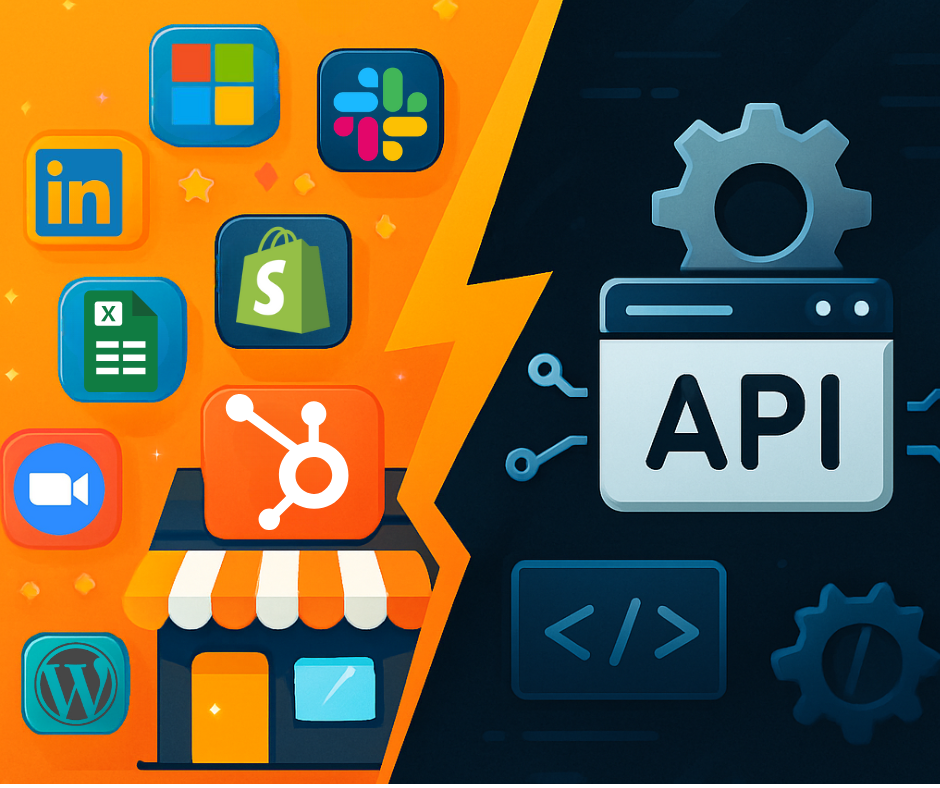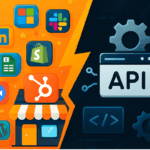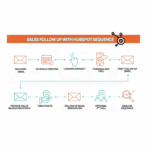
HubSpot App Marketplace vs. Custom API — Speed vs. Control
The Power of a Connected Tech Stack
A disconnected tech stack is one of the biggest silent killers of efficiency. When Sales data doesn’t flow to Finance, or Marketing activities aren’t logged in your project management tool, you end up with data silos, manual entry errors, inefficient workflows, and a fractured customer experience.
HubSpot is designed to be the central nervous system for your marketing, sales, and service data. Its true power is unlocked when it’s seamlessly connected to your other essential business tools (like ERPs, billing software, project management tools, or legacy systems).
To achieve this critical connectivity, you have two primary options: the user-friendly App Marketplace or powerful Custom API Development. This article will break down the pros, cons, and ideal use cases for each, providing a clear framework to help you decide which path is the best fit for your business goals, budget, and resources.

Deep Dive: The HubSpot App Marketplace
The App Marketplace is essentially an “app store” for HubSpot. It features thousands of pre-built, certified integrations developed by HubSpot partners and third-party companies, designed to be plug-and-play.
How It Works
These integrations typically operate via a simple setup wizard. Authentication is often handled seamlessly via OAuth, and the app is designed around standard use cases (e.g., connecting Zoom, Slack, or QuickBooks).
The Pros (The Case for Simplicity & Speed)
Fast Implementation: You can often go from zero to integrated in minutes or hours, not weeks or months. This dramatically accelerates your time-to-value.
Lower Upfront Cost: Many apps are free or freemium, requiring no large development costs. Paid apps typically have a predictable, manageable monthly subscription fee.
Reliability & Support: HubSpot vets the security of these apps, and ongoing technical support is provided by the app developer.
No Technical Expertise Needed: These integrations are designed for marketers, sales ops managers, and admins, requiring little to no developer involvement.
The Cons (Where It Falls Short)
Limited Flexibility: You are constrained by the features the app developer has built. You cannot customize the core functionality or the logic of the sync.
Rigid Data Mapping: The integration may not support syncing custom objects or specific fields that are unique to your business processes.
Potential for Ongoing Costs: While cheaper upfront, the subscription fees for multiple marketplace apps can add up over time.
May Not Exist for Niche Tools: If you use proprietary, in-house, or highly specialized industry systems, a marketplace app is unlikely to exist.

Decoding Custom API Development
If the App Marketplace is buying a suit off the rack, Custom API Development is tailored couture. It’s using HubSpot’s robust set of APIs (Application Programming Interfaces) to build a completely bespoke integration from scratch.
How It Works
This requires developers to write code (often using Python, Node.js, or Operations Hub Programmable Automation) that handles the secure communication between HubSpot and the other system’s API, managing authentication, data transformation, and error handling.
The Pros (The Case for Power & Precision)
Unlimited Flexibility: You build the exact workflow you need. You can sync any data, trigger any action, and create processes that match your unique business logic perfectly.
Solve Unique Problems: This is the only solution for integrating with proprietary in-house software or handling highly complex data transformations (e.g., aggregating data from five systems into one HubSpot property).
Full Data Control: You control precisely which data moves, when it moves (real-time vs. batch), and how it is formatted.
Competitive Advantage: A custom integration can create a unique, efficient process that gives your business a distinct competitive edge.
The Cons (The Trade-Offs for Control)
High Upfront Cost & Time: Custom development requires a significant investment in development resources (in-house or agency), often taking weeks or months to build, test, and deploy.
Requires Specialized Skills: You need developers experienced in HubSpot’s REST APIs, authentication protocols (like Private Apps and OAuth), and the specific architecture of the connected systems.
Ongoing Maintenance: You are responsible for maintenance. If HubSpot or the other system updates its API, your code may break and require costly updates.
Complexity & Risk: Building from scratch introduces more potential points of failure if not architected and tested properly (ideally in a HubSpot Sandbox).
Head-to-Head Comparison: A Quick-Glance Table
| Factor | HubSpot App Marketplace | Custom API Development |
| Cost | Low upfront, predictable subscription fees. | High upfront development cost, ongoing maintenance costs. |
| Speed | Fast (Hours to Days) | Slow (Weeks to Months) |
| Flexibility | Low to Medium (Constrained by app’s features) | High (Completely customizable to your exact needs) |
| Maintenance | Handled by the app developer. | Your team’s responsibility (or outsourced agency). |
| Skills Required | None to Low (User-level) | High (Experienced developers, RevOps/IT) |
| Best For | Standard use cases, quick wins, limited budgets. | Unique processes, proprietary software, complex data logic. |
The Decision Framework: How to Choose Your Path
Deciding which path to take requires asking critical questions about your business needs:
Choose the App Marketplace if…
A pre-built app exists that meets at least 80% of your requirements.
Your primary goal is to connect a well-known, public SaaS tool (e.g., Slack, Stripe, Zendesk).
Your timeline is short, and your budget for a custom build is limited.
You do not have the internal development resources to build and maintain code.
Choose Custom API Development if…
You are connecting to a proprietary or legacy in-house system where no app exists.
Your integration requires complex logic or unique data transformations that existing apps cannot handle.
The integration itself is a core strategic asset that gives you a competitive advantage.
You are willing to accept the high upfront cost and long-term maintenance responsibility.
Don’t Forget the Hybrid Approach: It’s rarely an either/or decision. Use native marketplace apps for standard, non-critical connections, and reserve custom development for the one or two truly unique, high-value integrations that separate you from the competition.
It’s About Fit, Not Just Features
The App Marketplace offers convenience and speed, perfect for accelerating early growth and connecting standard tools. Custom API Development, supported by tools like Operations Hub, offers control and precision, necessary for scaling complexity and competitive advantage.
Start by thoroughly exploring the App Marketplace. You might be surprised by what’s already available. If you hit a wall and the need is critical to your business, then it’s time to scope out a custom development project to build the perfect, tailored solution.
Ready to choose the perfect integration path and build a seamless tech stack?
Don’t waste time or budget on the wrong solution. Mobius NEXT specializes in both strategic App Marketplace optimization and advanced custom API development for HubSpot. We can help you analyze your needs and build a clear execution roadmap.
Request a free consultation with our HubSpot integration experts today to assess your needs.
Resources:
HubSpot App Marketplace: https://ecosystem.hubspot.com/marketplace/apps
HubSpot Developer Docs – CRM API Overview: https://developers.hubspot.com/docs/api/crm
HubSpot Developer Docs – Private Apps: https://developers.hubspot.com/docs/api/private-apps
HubSpot Operations Hub: https://www.hubspot.com/products/operations



